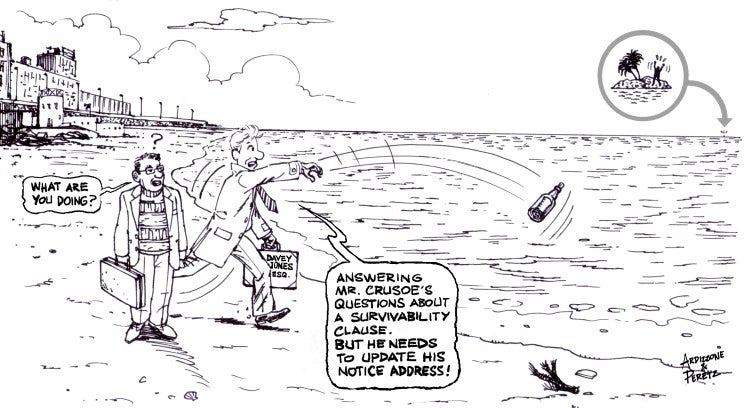
As in-house lawyers, we often focus on helping our clients put deals together. When negotiating agreements to document these deals, we must think ahead about how to measure success, what might go wrong, and what happens next. A key component of “what happens next” should include a plan for ending the relationship in an orderly manner.
Most organizations are overwhelmed with agreements with partners, customers, suppliers, and contractors. Each of these may result in a breakup. Operationally-focused in-house attorneys are those who understand the breakup provisions in their agreements and proactively communicate these to the business stakeholders who need to take action.
Breakups provide a great opportunity for in-house lawyers to bridge the gap from legal to business operations. In this article, we will discuss a few key sections of common business agreements and how lawyers need to extend awareness of these clauses to business teams on a regular basis.
No notice, no dice
Many agreements contain Notice provisions about how each counterparty should contact each other about issues in the relationship. The Notice address and acceptable methods of communication are not just pieces of data that should just be filed away with the rest of the agreement in the legal department repository. Your operations teams need to know the proper way to contact each counterparty.
If you send a notice to the wrong address or use an improper means of communication, it may not qualify as sufficient notice under the agreement. For example, a tenant who was notified of the new address of its landlord was deemed to be liable for nearly US$100,000 when the tenant failed to send notice of repair expenses to the landlord’s new address.
Consider situations where your organization may have promised a certain service level or uptime to a client. Often these service level commitments contain a carveout for scheduled downtime. When you have a planned outage, perhaps to upgrade your system, if you don’t provide notice of such forthcoming downtime to the proper address using the designated communication channels, your outage might not count as “scheduled” and trigger a violation of the service level commitments you made to your client. The result could be a breach of contract that enables your client to terminate or receive a credit — all because you did not look up the proper address.
When reviewing your contracts, it’s also important to keep track of which contact details your own organization specified for receiving notices from counterparties. An office move or personnel change may render the notice address specified in your agreement incorrect.
If you miss an important notice from a counterparty due to your own failure to inform the counterparty of your new contact details, it’s unlikely a court will have sympathy for you. A borrower from a bank discovered this hard truth when failing to prevent foreclosure of his home, with the court finding that “because Plaintiff failed to update his notice address as contractually required, Defendant mailed the notice to the proper address.”
If you do need to update your address, also be mindful of the specified mechanisms for doing so. In the aforementioned foreclosure action, the borrower alleged that he had notified the lender via telephone of an address change. The court found this unpersuasive because the contract required written notification of any address changes.
A matter of survival
Congratulations! You found the correct address of the counterparty and you sent the proper notice before the deadline. Time to forget it all and move on to the next agreement and relationship? Not just yet … Many of your agreements have responsibilities for your organization that persist beyond the termination of the agreement itself.
You need to educate your business colleagues in multiple departments when they have ongoing obligations stemming from business relationships that have otherwise ended. These responsibilities could extend to your accounting, compliance, operations, and human resources teams.
Keeping your human (resources) in the loop
In many business relationships, companies are worried about their employees being lured away by a counterparty. They seek to prevent such risks by including a non-solicitation clause, which may be mutual, in agreements where their valued employees may interact heavily with the counterparty.
It’s not uncommon for these non-solicitation clauses to survive the end of the contract for a year or two. Accordingly, if a contract with such a clause has ended and the non-solicitation clause remains in effect, you need to put your human resources team on alert about how much longer they may need to wait before recruiting from a former counterparty.
The post-mortem post-mortem
Agreements where one party earns a commission or other fee based on the work of counterparty, such as a reseller of software, often include provisions enabling the party to whom money may be owing to audit the records of the counterparty. Typically, such audit provisions extend for a finite period of time after termination of the underlying business relationship.
As soon as your organization terminates an agreement, you need to determine whether your organization has such audit rights and when they end. Because you no longer have the goodwill of an ongoing relationship with the counterparty, don’t be surprised if they are uncooperative with your audit requests if they are untimely.
TTFN TMI
In the course of a business relationship, your organization may have shared trade secrets, confidential information, and non-public personally identifiable information about employees and clients with your counterparties. While your agreement with the counterparty may contain a confidentiality clause, when a relationship ends you need to quickly examine the extent to which those confidentiality obligations survive termination of the agreement. If there is little or no survivability of confidentiality requirements, you need to be prepared to quickly request the return of all sensitive information provided to the counterparty.
Have a plan
Before you end a contractual relationship, read beyond the Termination section of the governing agreement to determine what actions everyone in your organization needs to take to protect your information, your employees, and your rights. Proactively engage the other departments in your organization and educate them about their role in the offboarding process.
In addition to increasing your own visibility as a trusted advisor to your internal clients, developing and quarterbacking implementation of this plan will help you learn how you might want to restructure future relationships to reduce the risk and cost of breakups.




